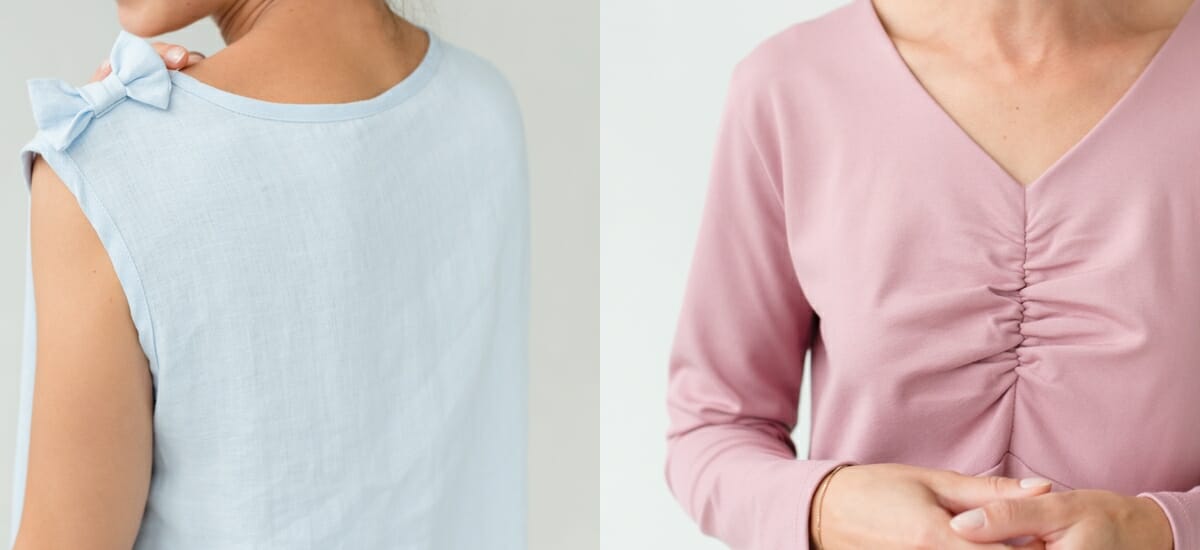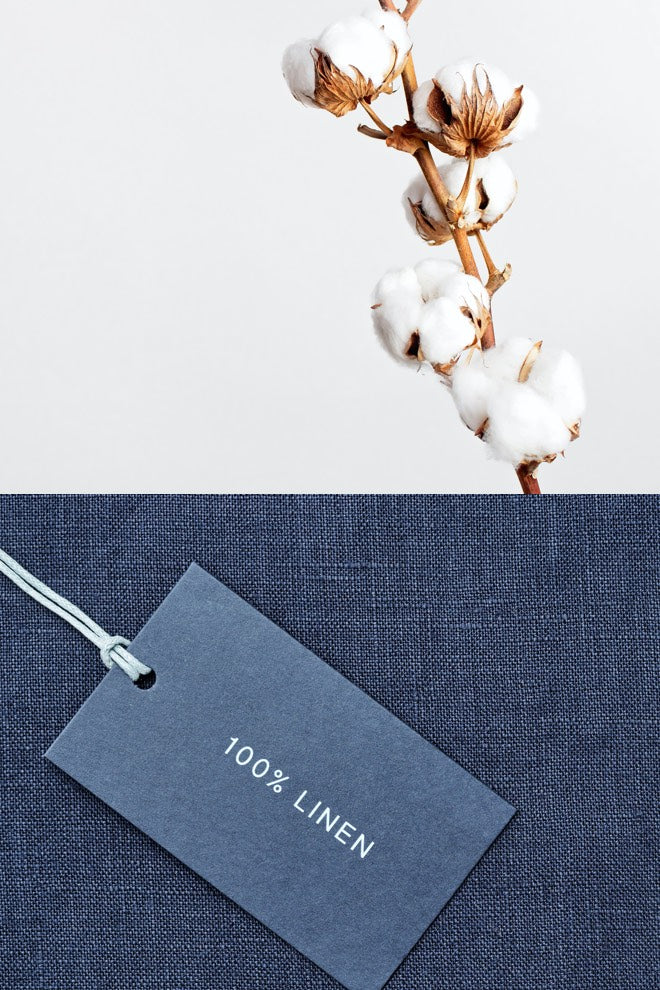In this article we will cover the following questions:
What is linen?
What is cotton?
Linen vs. Cotton - differences between the textiles:
What is linen?
The word linen comes from the Latin name for flax and it is a natural textile made from flax plant. The flax plant is an annual crop that is highly cultivated in many cooler areas of the world. The linen fabric is made from the flax fibers that grow inside of the plant. Over the course of time, people have invented and used certain techniques for flax processing.
The fibers of the flax plant are naturally strong but nevertheless must be extracted with special care in order to avoid any possible damage and ensure the making of the high-quality linen fabric.
Linen has a lot of benefits, just like cotton. Linen fabrics are very durable and breathable, sustainable and it's a perfect choice for those with a sensitive skin.
What is cotton?
Cotton is a soft natural textile which is derived from a cotton plant and is very popular in many households. The word cotton comes from the Arabic word “qutun” and is described as a staple fiber. Cotton fabric is created from the cotton fibers that greatly variate in length. The material is very soft as the fibers of cotton are very fluffy. The term “cotton” comes from the part of the cotton plant that grows in the boll.
Cotton textiles are being used to create a lot of products, from kitchen towels to summer dresses. When you are investigating your products, you will find that they are either from plain cotton, mixed cotton, or dyed cotton.
Cotton has a lot of benefits, that is why it's one of the most popular materials: same as linen, it's very soft, durable, absorbent and breathable, the only difference that cotton holds dye better.
Linen vs. Cotton - differences between the textiles
Although it might seem that both cotton and linen are very similar materials, there are some main differences which you should know about.

1. Visual characteristics
Usually cotton bobbles more than its counterpart linen, meaning that over time the material, especially if it is being highly used at all times, gets small ball-shaped threads on the surface. It happens as cotton fibers are generally weaker than linen’s. However, fear not, because you can always find and buy a gadget that is specifically designed to remove unwanted fluff and bobbles.
Moving on, linen is evidently more wrinkly than cotton. Both materials can wrinkle easy because they are made from natural fibers, but linen has more stiffness, therefore, is more prone to wrinkles.
2. Durability
Both linen and cotton are very durable and completely natural textiles. Nevertheless, cotton is a slightly more flexible material than linen and can stretch better. Although cotton has the before mentioned qualities, linen is more durable than cotton.
If you take proper care of your linen products, they will last you up to several decades. If you take good care of your cotton garments, they will also last you well. It all depends on the quality of the material and how well you take care of it. Cotton can last from 3-5 years to several decades.
If you decide to buy finer cotton, like Egyptian, know that it is made from long-staple fibers of cotton. These kinds of fibers make this cotton softer and better lasting than standard cotton. Anyhow, on the matter of durability, cotton loses to linen.
You can easily note that linen is way more rigid than cotton, but it also lasts longer because the yarn, from which the material is made, has tightly wrapped cellulose fibers. The fibers are also longer than the ones in the cotton yarn.
3. Drying
The quick-drying ability is seen in both materials. Linen is well known for being able to “magically” wick the moisture. When it is hot and the body starts to sweat, linen material draws the liquid out of your skin and proceeds to dry quickly. It works with all kinds of liquids. As mentioned before, cotton also sports this ability to draw out the water, but linen dries faster than cotton.
4. Absorbency
Cotton and linen fabrics have a fascinating power of absorbency. It is also known that water strengthens the fibers of both materials. Cotton is a little better absorbent than linen. Generally, cotton can hold approximately 25% of its weight in water, while linen holds up to 20%.
5. Breathability
Both natural materials are known to be very breathable, although there are some differences between linen and cotton.
The breathability of cotton material depends entirely on how the fabric was made. It correlates directly with the weave of the fabric but not with the fibers of cotton themselves. Some materials of cotton, like denim or canvas are relatively less breathable, because they are thicker.
The breathability of linen depends on the flax linen fibers. The fibers are hollow, therefore, the linen material is highly breathable, meaning that air and water can circulate with ease. So it's obvious that linen is more breathable than cotton.
6. Thermoregulation
You probably have heard about the cooling powers of linen material. That is the truth, linen is highly thermoregulatory material which has the ability to cool you down in hot environments and also can trap the heat when the environment is cold. However, it is advisable to layer linen, if the environment is very cold. Cotton, on the other hand, does not have these strong thermoregulatory qualities, linen keeps you cooler than cotton.
7. Hypoallergenic
Both materials are natural, meaning that they can most definitely be used by people suffering from allergies. Although cotton is great for sensitive skin and people with skin problems, linen is slightly more beneficial.
The material of linen is also great for sensitive skin, nonetheless, it is also just the perfect material for people that suffer from dust and allergies caused by small particles. The reason why linen is amazing in these kind of situations is because it has a lower thread count and is made from loose weave.
8. Softness
Is linen soft as cotton material? Maybe they are both known for this advantage?
The reality is, that normally cotton is softer to the touch, simply, because linen has rougher fibers than cotton.
However, linen material gets softer and softer with each and every wash, not mentioning that despite the washes, linen can easily last you for up to 30 years! While cotton material is very soft from the start and normally lasts about 5 years.
9. Texture
It comes to no surprise that the texture of these two beautiful materials is different. The fabric of cotton is quite smooth, while linen material looks and feels quite rough compared and has a textured pattern, which is a result of the loose weave.
10. Weight
Linen is a very lightweight fabric because the fibers are hollow, while cotton material is medium weight mostly, because of a tighter weave. Cotton is much more versatile, but if you want a light clothes, linen is a better option.
Conclusion: Pros and Cons of linen and cotton
| Material | Linen | Cotton |
|---|---|---|
| Pros | Highly durable Very breathable Anti-static Natural and ecological Hypoallergenic Softens & strengthens after every wash |
Wide range of materials and weaves Wide range of prices Durable Available worldwide Softens after every wash |
| Cons | Thick and coarser texture and feeling Wrinkles easily Not a cheap option Limited colour options |
Wrinkles easily Not as durable as synthetics More expensive than synthetics Prone to shrinkage |
Wearing natural materials is becoming an essential thing for many people worldwide. You might be a fan of cotton, linen, or you could be interested in them both! We brought you some differences between these beautiful materials but which one to choose is up to you. LeMuse loves working with linen fabric because we adore how versatile and advantageous it is.

